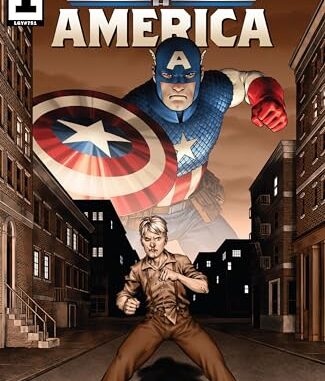
Comics can be the most interesting when they intersect history and good storytelling. This is where Steve Rogers gets revitalized. His origin story is well known through both the Marvel Cinematic Universe and in his first appearance in 1941. Cocreated by Joe Simon and Jack Kirby, Steve Rogers, all of 5 feet and 90lbs soaking wet wanted to contribute during World War II. Rejected by the military, he is recruited for the super soldier program, becomes Captain America, then in 1943 is lost to the world. A generation later he emerges from being trapped in ice, joins the Avengers and has been a major character in Marvel Comics for well over 80 years. So how do you make Captain America interesting, an American symbol for the idealization of western civilization? You look back to before Steve Rogers became Captain America.
The cover of issue one “Captain America” gives everything and nothing away as we see Steve in his present-day uniform looming over a 16-year-old Steve with an old-world background of New York. Battered and bloodied, a young Steve shows the same fierce determination as the man in uniform. As you start reading, we see him on an assignment, driving his motorcycle through a building trying to apprehend some creature. But then it shifts to Steve who’s currently living in the apartment building he grew up in. His dilapidated home makes you wonder about the Avengers’ salary. Do they have a proper healthcare plan, and why does Steve Rogers have to ask for a loan against his paycheck? With a secure home though he begins to rebuild, recruit a landlord, Steve always finds a way of getting by. For Steve, he’s reclaiming his personal history. He’s not gentrifying the neighborhood; this was his home and perhaps he wants to exorcise some demons. This is where the seamless nonlinear storytelling starts to deviate from the origin story we know and treads into some historical fiction.
Getting by meant being homeless at the age of 14, having no one, then a couple of years later living in a supply closet in a boarding house. All this is intermingled with Steve’s memories of the past and the current mission he finds himself to be the center of. J. Michael Straczynski with his compelling narrative is equally matched with the artwork of Jesus Saiz, color artist Matt Hollingsworth and letterer VC’s Joe Caramagna. In a panel early on in issue one Steve is having a conversation with one of the tenants. He talks about his father dying shortly after the First World War, and those eyes, that facial expression simultaneously is inscrutable and all-knowing. To anyone who’s ever experienced having to grow up quickly they’ll recognize Steve’s face. The trauma of having to take on adult responsibilities, while being orphaned. The resourcefulness and the hustle Steve had to do to survive was one of the key things that makes him a leader by example. Most importantly, we see Steve’s vulnerability. When he says “I got by” only the reader and Steve knows what he means. That intimacy within a comic book is a Straczynski trademark. We saw it on his run of Thor and his 12-issue miniseries “Midnight Nation.” There are moments where we are like Uatu, The Watcher, privy to the information of a character that he doesn’t share with anyone. It makes us invested
Some time goes by and it’s 1938, three years before the U.S. gets into World War II. There’s a nazi rally in the park. Steve can’t believe it. However, this wasn’t unusual. There had been rallies going back to when Hitler came into power in the early 30’s. In 1939 there was a nazi rally at Madison Square Garden that is referred to in a later issue in the series. Nazis used Jim Crow laws as part of their genocidal playbook. For Steve history doesn’t repeat itself, instead it’s an ongoing cycle where time is a corrupted construct.
There are also appropriate cameos from Peter Parker, Doctor Strange, Misty Knight and others. It seems that Steve and others are being targeted for being crux points. This story arc is funny, startling, hopeful and will have you fully invested in a 100-year-old man, who’s enemies are monsters masquerading as human. Some are actual demons, but others are men who have no humanity. Luckily, he has allies from the past and present.

Leave a Reply